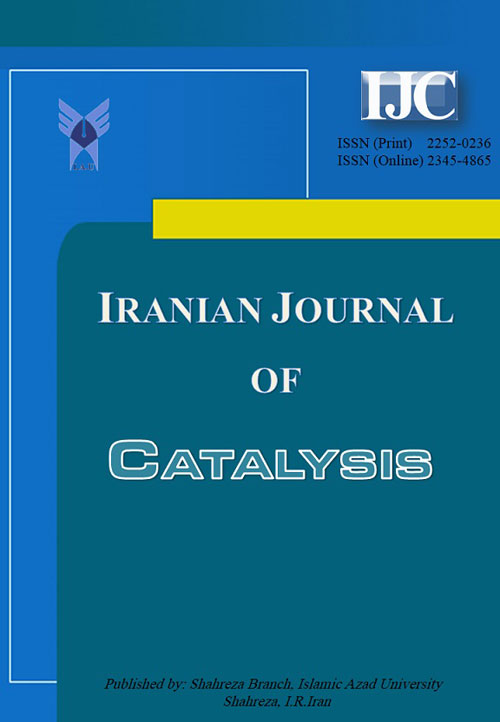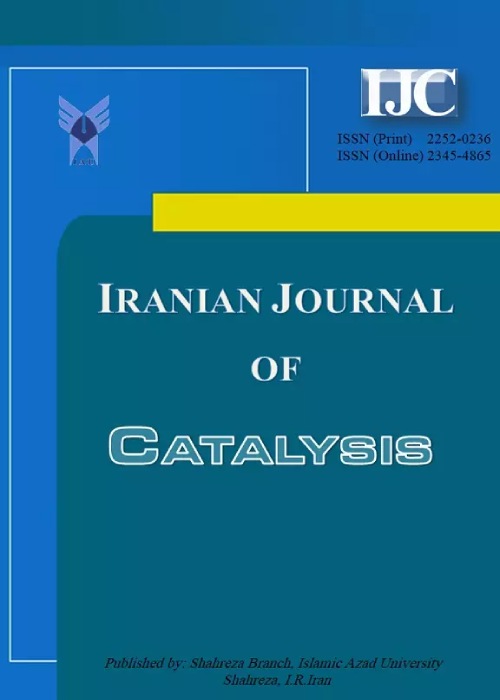فهرست مطالب

Iranian Journal of Catalysis
Volume:6 Issue: 2, Spring 2016
- تاریخ انتشار: 1395/02/15
- تعداد عناوین: 15
-
-
Pages 99-105A green and efficient protocol for the synthesis of 3,3,6,6-tetramethyl-9-aryl-1,8-dioxooctahydroxanthene derivatives via cyclocondensation of 5,5-dimethyl-1,3-cyclohexanedione and aromatic aldehydes in the presence of catalytic amount of 10-molybdo-2-vanadophosphoric acid under solvent-free conditions has been described. The 10-molybdo-2-vanadophosphoric acid was prepared and characterized by FT-IR spectroscopy, thermal analysis and XRD analysis techniques. Characterization of the catalyst by FT-IR spectroscopy confirms the substitution of two Mo6 ions by a V5 ion in a Keggin structure. The effect of various reaction parameters on the rate of reaction was investigated. The reaction was carried out without using any solvent and the process subscribes to the principles of green chemistry. Moreover, the present protocol offers several advantages such as simple work-up, shorter reaction time, excellent yields, recovery and reusability of catalyst.Keywords: 1, 8, Dioxooctahydroxanthenes, Heteropoly acids, 10, molybdo, 2, vanadophosphoric acid, Heterogeneous catalyst, Solvent, free
-
Pages 107-112Catalytic activity of AlHMS was investigated as a cheap heterogeneous reusable catalyst in some multi-component reactions for the synthesis of various chromenes. Three-component reaction of 2-hydroxy-naphtoquinone with an aromatic aldehyde and dimedone or barbituric acid in H2O under reflux conditions was performed using AlHMS in relatively good yields. The approach was more extended using psuedo five-component reaction of 2,5-dihydroxy-1,4-benzoquinone, two equivalent of an aromatic aldehyde and two equivalent of dimedone or 1,3-cyclohexadione with efficient catalytic effect of AlHMS. Three-component reaction of an aldehyde, malononitrile and 1-naphthole in the presence of AlHMS gave 2-amino-4-phenyl-4H-benzo[h]chromene-3-carbonitriles in high yields. The work-up procedures are very simple, and the products do not require further purification. The catalysts can be recycled and reused for several times without observable loss of performance.Keywords: AlHMS, Chromene, Heterogeneous catalyst, Multi, component, Green chemistry
-
Pages 113-119Phthalimide was reacted with chlorosulfonic acid to give sulfonic acid-functionalized phthalimide (SFP), which characterized by 1H NMR, 13C NMR, FT-IR, XRD (X-ray diffraction), SEM (scanning electron microscopy), EDX (energy-dispersive X-ray), mass and DTG (derivative thermal gravimetry) spectra. Afterward, its catalytic activity was examined for the condensation of arylaldehydes with 2-naphthol under solvent-free conditions to afford 14-aryl-14H-dibenzo[a,j]xanthenes. The results showed that SFP was highly efficient catalyst to promote the reaction. The advantages of this work include generality, efficiency, short reaction times, excellent yields, synthesis of the catalyst using available and inexpensive reactants, performing the reaction in milder conditions relative to most of the reported catalysts, and good agreement with the green chemistry protocolKeywords: Sulfonic acid, functionalized phthalimide (SFP), Arylaldehyde, 2, Naphthol, 14, Aryl, 14H, dibnzo[a, j]xanthene, Solvent, free
-
Pages 121-125A series of arylidine barbituric acid derivatives was synthesized by Knoevenagel condensation reaction of aromatic aldehydes with barbituric acid or thiobarbituric acid using dodecylbenzenesulfonic acid as a Brønsted acid-surfactant catalyst in aqueous media. Regardless of the nature of the substitution (electron-donating and -withdrawing), all the reactions were completed within 15-65 min in water at reflux condition. In these reactions, there was no need for the column purification of the products. The present methodology offers several advantages such as excellent yields, simple procedure and work-up steps, short reaction times, as well as inexpensive and non-toxic catalyst. Use of water as the reaction medium makes the process environmentally benign.Keywords: Arylidine barbituric acid, Dodecylbenzenesulfonic acid (DBSA), Knoevenagel condensation, Aqueous Media
-
Pages 127-131In this research work, we reported oxalic acid dihydrate as a green, mild and efficient catalyst for the one-pot three-component Biginelli synthesis of 3,4-dihydropyrimidin-2-(1H)-one derivatives from reaction between β-keto esters (methyl or ethyl acetoacetate), aromatic aldehyde (benzaldehye derivatives) and urea or thiourea under thermal and solvent-free conditions with excellent yields and short reaction time. The most benefits of this synthetic method is including green methodology, eco-friendly, inexpensive and non-toxic catalyst, solvent-free conditions, materials available, and simple operational procedure with no column chromatographic separation. The products have been characterized by melting points, IR and 1H NMR spectroscopy. In this research workKeywords: Oxalic acid.2H2O, Green methodology, Biginelli reaction, 3, 4, Dihydropyrimidinone
-
Pages 133-139Succinimidinium hydrogensulfate ([H-Suc]HSO4), as a new and stable derivative of succinimide, is easily prepared by the reaction of succinimide with neat sulfuric acid. This ionic liquid can be used as an efficient catalyst for the acetylation of alcohols, phenols, thiols and amines at room temperature under mild and solvent free conditions. All the products are separated and identified using different types of methods including FT-IR, 1H NMR and 13C NMR spectroscopy. This new method consistently has the advantages of chemoselectivity, excellent yields of the products and short reaction times. Further, the catalyst can be reused and recovered for several times without any variations in the yield of the product.Keywords: Succinimidinium hydrogensulfate ([H, Suc]HSO4), Acetylation, Solvent free conditions, Reusability of the catalyst, Ionic liquid
-
Pages 141-145A new organocatalyzed method is developed for BaylisHillman reactions of cyclohex-2-enone with various aromatic aldehydes in the presence of water and catalytic quantities of triethylamine. All reactions take place at room temperature and relatively good yields of various products are obtained within a time frame which does not exceed 24 hours. The mild reaction conditions used in the present method and the versatility of the process are the main advantages of this procedure. As a result, products of the BaylisHillman reaction of cyclohex-2-enone with various aromatic aldehydes bearing electron withdrawing and electron releasing groups are obtained under inexpensive organocatalytic conditions.Keywords: Baylis–Hillman reaction, Organocatalyst, Aqueous conditions, Room, tempearture
-
Pages 147-152Thiamine hydrochloride (Vitamin-B1) has been utilized as an effective biodegradable catalyst for the one pot synthesis of polyhydroquinoline derivatives via four component reaction of dimedone, aldehyde, ethylacetoacetate and ammonium acetate in ethanol under mild conditions. The method presented here offers several advantages over reported procedures in terms of environmentally benign catalytic system and excellent product yields (75-98%) of polyhydroqninoline compounds. Aromatic and heteroaryl aldehyde with electron donating as well as electron withdrawing group undergo smooth reaction to afford the corresponding polyhydroquinoline derivatives. The synthesized polyhydroquinoline compounds were characterized by IR, NMR and Mass spectral data. The present article describes the new application of Vitamin-B1.Keywords: Thiamine hydrochloride (Vitamin, B1), Dimedone, Aldehyde, Ethylacetoacetate, Ammonium acetate, Polyhydroqninoline, Green protocol
-
Pages 153-159Polyvinylpolypyrrolidone supported chlorosulfonic acid ([PVPP-SO3H]) was synthesized and evaluated as a recoverable catalyst for the one-pot synthesis of hexahydroquinolines by reaction of arylaldehydes, dimedone (5,5-dimethylcyclohexane-1,3-dione) or 1,3-cyclohexanedione, ethylacetoacetate and ammonium acetate in high to excellent yield in ethanol at 70 °C. The [PVPP-SO3H] catalyst was characterized via Fourier transform infrared spectroscopy (FT-IR) and thermal gravimetric analysis (TGA). The capacity of the reagent was determined by titration and found to be 12 mmol/g, which shows a high loading of H per gram of the catalyst. Moreover, the catalyst could be recycled several times without significant loss of its catalytic activity. Clean methodologies, easy work-up procedure, high yield and simple preparation of the catalyst are some advantages of this work.Keywords: Polyvinylpolypyrrolidone, Chlorosulfonic acid, Multicomponent reaction, Hexahydroquinolines
-
Pages 161-166A simple, highly efficient and green procedure for the condensation of o-phenylenediamines with 1, 2-dicarbonyl compounds in the presence of vitamin C, as an inexpensive organocatalyst, is described. Using this method, variety of quinoxaline derivatives with different electron releasing and electron withdrawing substituents, are produced in high to excellent yields at room temperature in ethanol. The remarkable features of this new protocol are high to excellent conversions, relatively short reaction times, and clean reaction profiles, simple and easy experimental and work-up procedures. Thus we have been able to report another ability of vitamin C in organic chemistry synthesis which has less disastrous effect in the atmosphere and human survival.Keywords: Quinoxalins, Vitamin C, o, Phenylenediamines, 1, 2, Dicarbonyl compounds, Organocatalyst
-
Pages 167-172Several aromatic aldehydes are efficiently condensed with 2'-hydroxyacetophenone by polymer-supported basic ionic liquid as an excellent heterogeneous catalyst utilizing the ClaisenSchmidt reaction. Microwave irradiation has been employed, providing flavanone in good yield and short reaction time.
Several aromatic aldehydes are efficiently condensed with 2'-hydroxyacetophenone by polymer-supported basic ionic liquid as an excellent heterogeneous catalyst utilizing the ClaisenSchmidt reaction. Microwave irradiation has been employed, providing flavanone in good yield and short reaction time.Keywords: Polymer, supported catalyst, Immobilization, Basic Ionic liquid, Flavanone -
Pages 173-179Silica Vanadic Acid, SVA, (oxo-vanadium has been supported on silica) as a dual Lewis and Bronsted acid ability was prepared and efficiently catalyzed one-pot multi-component condensation of enolizable ketones or alkyl acetoacetates with aromatic aldehydes, acetonitrile and acetyl chloride. The described reaction was produced β-acetamido ketone or ester derivatives in high to excellent yields in relatively short reaction times in heterogeneous catalytic system at room temperature. Other advantages of this method is applicable at large scales without significant loss of the yields. In addition, this method is superior to reported methods, for the synthesis of β-acetamido ketone or ester derivatives.Keywords: β Acetamido ketone, β Acetamido ester, Silica vanadic acid (SVA), Enolizable ketone, Multi, component reactions, Dakin west
-
Pages 181-187A rapid, green and efficient method for the synthesis of 14-aryl-14H-dibenzo[a,j]xanthene derivatives through a one-pot condensation of 2-naphthol with various aromatic aldehydes in the presences of several acidic ionic liquids including [PSMIM]Cl, [BMIM]HSO4, [BMIM]Cl, [BMIM]Br, and [BMIM]BF4 as organocatalysts and task-specific acidic ionic liquids (AILs) under solvent-free conditions is described. Compared with other synthetic methods, this new method has the advantages such as milder reaction conditions, good to excellent yields, short reaction times, and environmentally benign procedure. Also, 1-(1-Propylsulfonic)-3-methylimidazolium chloride [PSMIM]Cl acts as a catalyst under solvent-free conditions and can be recovered and reused six times without apparent loss of its catalytic activity.Keywords: Ionic liquids, One, pot reaction, 2, Naphthol, Aldehydes, Reusable catalyst, Xanthenes
-
Pages 189-192In the present work; we have developed a mild, efficient, environmentally benign method for the synthesis of tetrahydrobenzo[b]pyran derivatives via a three-component cyclocondensation of aldehydes, malononitrile and dimedone utilizing ammonium chloride as a simple, easily available and cost effective catalyst under microwave irradiation in excellent yield. This method has several attracting features such assimple experimental set up, easy work up procedure, cleaner reaction profile high conversionsand shorter reaction time affording the products in moderate to excellent yield. The use of MW irradiation and a catalytic amount of NH4Cl was successful to afford excellent yield of products in shorter reaction time. Thus the present method provides a valuable addition to the existing methods for the synthesis of these heterocyclic compounds.Keywords: Tetrahydrobenzo[b]pyrans, Ammonium chloride, MW irradiation
-
Pages 193-196Cross-linked poly(vinylpyrrolidone) (PVP) is a heterogeneous and polymeric support that has been widely used in the preparation of numerous reagents and catalysts because of its commercial availability, stability, reasonable high loading capacity, good physicochemical structure and facile functionalization. Beside various applications in industry such as stabilizer, sugar coating and film coating , this polymer can be an attractive support to immobilize mineral acids because of the basic nature of its pyridyl group. Therefore, recent applications of poly(vinylpyrrolidone) as a reagent support have been extensively investigated. In this spotlight we have a brief review on the applications of the modified poly(vinylpyrrolidone) in the promotion of some of the important organic transformations.Keywords: poly(vinylpyrrolidone), Heterogeneous catalysts


